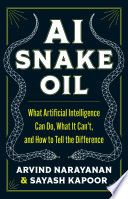

One of the central themes of 'AI Snake Oil' is the misconception surrounding artificial intelligence as a form of true intelligence. The book argues that while AI systems can process data and execute tasks with remarkable efficiency, they lack the cognitive abilities and understanding that characterize human intelligence. This is particularly relevant in discussions about AI's role in decision-making processes. The author emphasizes that AI should be seen as a tool rather than a replacement for human judgment. The illusion of intelligence often leads to over-reliance on AI systems, which can result in poor decision-making and unintended consequences. The book encourages readers to critically evaluate the capabilities and limitations of AI, urging them to approach AI solutions with a balanced perspective.
Continue readingThe book delves into the concept of the hype cycle, which describes the phases of public expectations surrounding new technologies. AI has gone through significant hype, with exaggerated claims about its capabilities leading to inflated expectations. The author discusses how this hype can lead to disillusionment when the technology fails to deliver on its promises, ultimately settling into a more realistic understanding of AI's potential. The book illustrates this cycle with real-world examples, highlighting how organizations can get caught up in the excitement of AI without fully understanding its practical applications. By recognizing the hype cycle, readers can make more informed decisions about AI investments and implementations.
Continue readingAI Snake Oil places a strong emphasis on the ethical implications of deploying AI technologies. The author discusses the importance of accountability, particularly in cases where AI systems make decisions that significantly affect people's lives. The book raises questions about who is responsible for the actions of AI—developers, companies, or the systems themselves. It also explores the potential for bias in AI algorithms, which can perpetuate existing inequalities. The author advocates for the establishment of ethical guidelines and accountability frameworks to ensure that AI is used responsibly. This idea resonates with readers who are concerned about the societal impact of technology and the need for ethical considerations in innovation.
Continue readingRather than viewing AI as a replacement for human labor, the book argues for its role as a complementary tool that enhances human capabilities. The author emphasizes the potential for AI to automate repetitive tasks, allowing humans to focus on more complex and creative endeavors. This perspective encourages organizations to adopt a collaborative approach, integrating AI into workflows in ways that amplify human strengths. The book provides examples of successful human-AI collaboration, demonstrating how businesses can leverage AI to improve productivity and innovation. This idea is particularly relevant for leaders and managers looking to navigate the evolving landscape of work in the age of AI.
Continue readingThe book highlights that the effectiveness of AI systems is heavily dependent on the quality of the data they are trained on. Poor data quality can lead to inaccurate predictions and misguided decisions, undermining the value of AI. The author stresses the need for organizations to prioritize data governance and quality assurance to ensure that their AI initiatives yield meaningful results. This idea serves as a reminder that successful AI implementation is not just about the technology itself, but also about the underlying data infrastructure. Readers are encouraged to invest in data management practices that support their AI goals.
Continue readingAI Snake Oil explores the implications of AI on the future of work, addressing concerns about job displacement and the evolution of job roles. The author argues that while some jobs may be automated, new opportunities will emerge that require human skills that AI cannot replicate, such as emotional intelligence and creativity. The book encourages readers to embrace lifelong learning and adaptability as essential skills for thriving in an AI-driven economy. It also discusses the role of education in preparing the workforce for the changes brought about by AI, urging educational institutions to adapt their curricula to meet the demands of the future job market.
Continue readingThe final key idea in 'AI Snake Oil' is the importance of setting realistic expectations for AI projects. The author cautions against the temptation to pursue AI initiatives without a clear understanding of their objectives and potential challenges. Successful AI implementation requires careful planning, stakeholder engagement, and a willingness to iterate based on feedback and results. The book provides practical advice for organizations looking to embark on AI projects, emphasizing the need for a strategic approach that aligns AI initiatives with business goals. This idea resonates with readers who are considering AI investments and want to avoid common pitfalls associated with technology adoption.
Continue reading